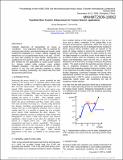Nanofluid heat transfer enhancement for nuclear reactor applications
Author(s)
Buongiorno, Jacopo; Hu, Lin-Wen
DownloadBuongiorno_Nanofluid Heat.pdf (1.455Mb)
PUBLISHER_POLICY
Publisher Policy
Article is made available in accordance with the publisher's policy and may be subject to US copyright law. Please refer to the publisher's site for terms of use.
Terms of use
Metadata
Show full item recordAbstract
Colloidal dispersions of nanoparticles are known as `nanofluids'. Such engineered fluids offer the potential for enhancing heat transfer, particularly boiling heat transfer, while avoiding the drawbacks (i.e., erosion, settling, clogging) that hindered the use of particle-laden fluids in the past. At MIT we have been studying the heat transfer characteristics of nanofluids for the past five years, with the goal of evaluating their benefits for and applicability to nuclear power systems (i.e., primary coolant, safety systems, severe accident mitigation strategies). This paper will summarize the MIT research in this area with particular emphasis to boiling behavior, including, prominently, the Critical Heat Flux limit and quenching phenomena.
Date issued
2009-12Department
Massachusetts Institute of Technology. Department of Nuclear Science and Engineering; MIT Nuclear Reactor LaboratoryJournal
Proceedings of the ASME 2009 2nd Micro/Nanoscale Heat & Mass Transfer International Conference, MNHMT 2009
Publisher
American Society of Mechanical Engineers
Citation
Buongiorno, Jacopo, and Lin-wen Hu. “Nanofluid Heat Transfer Enhancement for Nuclear Reactor Applications.” ASME, 2009. 517-522. ©2009 ASME.
Version: Final published version
Other identifiers
Paper no. MNHMT2009-18062
ISSN
978-0-7918-4391-8